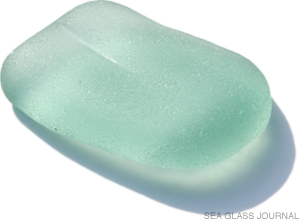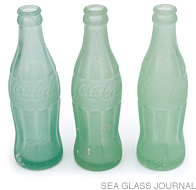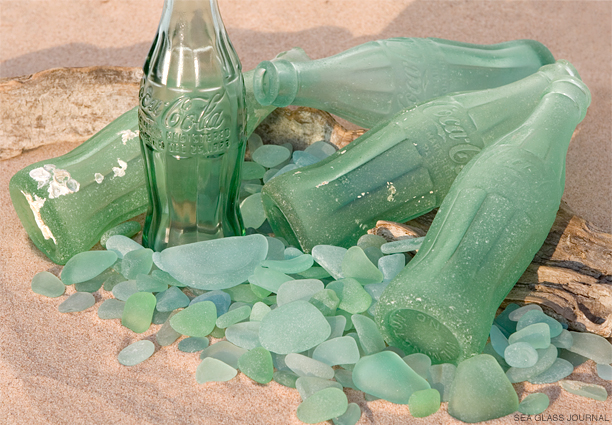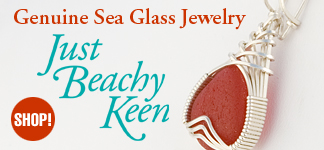The Sea Glass Shard of the Month: June 2016
A Seafoam Coke Sea Glass Shard

Things go better with Coke...
Sea Glass Specifications:
Color: Seafoam Green
Max Length: 42.5 mm (1.67")
Max Width: 31.0 mm (1.22")
Avg Thickness: 4.5 mm (1.77")
Weight: 17.9 grams (0.63 oz)
Estimated Age: 30 to 70 Years Old
This month's featured sea glass shard is a seafoam colored gem from the bottom side of a Coca Cola bottle found on the beaches of Puerto Rico. It is easy to determine the origins of this specimen due to the unmistakable rib line that appears on the side.
Known as the "Mae West" or "hobble skirt" bottle for its resemblance to a fashionable dress of the period, the Coke bottle was the result of a two-year search starting in 1912 to create something "unique and instantly recognizable" for the Coca-Cola brand.[1] The shape, inspired by the cocoa pod including the bulging middle and the parallel ribs, was designed by the Root Glass Company. Patented in 1915 it became standard across all Coca-Cola bottlers.

The cocoa pod was the inspiration for the now famous Coca Cola bottle design. Photo courtesy of the World Cocoa Foundation.

These surf-tumbled Coke bottles demonstrate the slight variations in hue from an aquamarine to a seafoam color.
The Coke bottle shape was inspired by the cocoa pod including the bulging middle and the parallel ribs.
The seafoam color of the Coke bottle generally remained the same with the standardized shape, with only slight variations from a greener to a bluer hue. While the major influence of this soft aquamarine color was due to the natural impurities of iron in the sand, the slight variations from green to blue may also be the result in the mixing and melting of the glass.[2]
A "reducing" flame, or one with less oxygen supplied for burning, might produce a bluish-green because the iron in the sand might then be reduced to one of the bluer iron oxides - an excess of air might make the oxidized green iron oxides predominate.[3]
The many different Coke bottling locations, along with the variations in the flame used throughout the day, probably was the major reason for the slight variations in the bottle colors.
While seafoam may not be categorized among the common colors of sea glass, some beach locations, where people may have gathered to socialize at one time or another, may yield an incredible amount of this light aquamarine shade due to the popularity of Coca Cola as a soft drink.
Keep up-to-date on all things sea glass... like us on Facebook!
Sea Glass Journal on Facebook

REFERENCES:
1. http://www.collectorsweekly.com/coca-cola/bottles
2. http://www.sha.org/bottle/colors.htm
3. Julian Toulouse: A Collector's Manual - Fruit Jars






